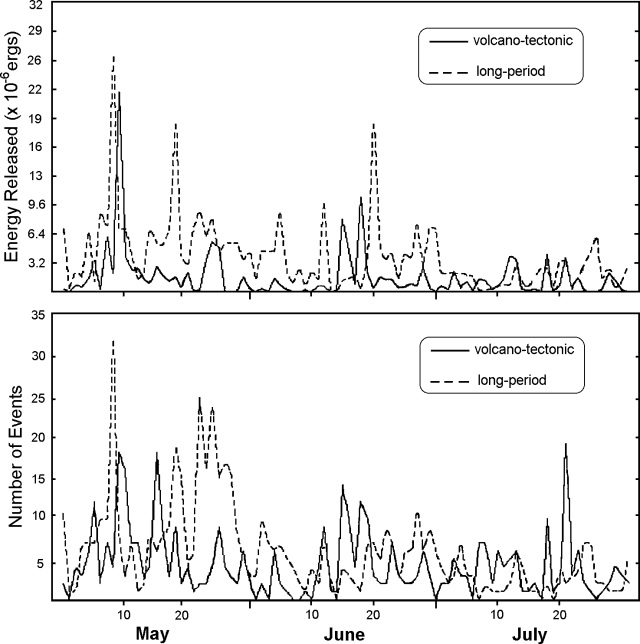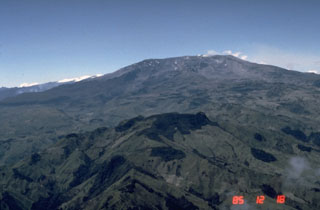Report on Nevado del Ruiz (Colombia) — September 1996
Bulletin of the Global Volcanism Network, vol. 21, no. 9 (September 1996)
Managing Editor: Richard Wunderman.
Nevado del Ruiz (Colombia) Seismic swarms; gas plumes; newly found fumarolic field and hot spring
Please cite this report as:
Global Volcanism Program, 1996. Report on Nevado del Ruiz (Colombia) (Wunderman, R., ed.). Bulletin of the Global Volcanism Network, 21:9. Smithsonian Institution. https://doi.org/10.5479/si.GVP.BGVN199609-351020
Nevado del Ruiz
Colombia
4.892°N, 75.324°W; summit elev. 5279 m
All times are local (unless otherwise noted)
During May-July, seismic activity at Ruiz remained quite low. Significant volcano-tectonic earthquake swarms occurred on 8, 10, 11, 16, and 23 May, and 7, 15, and 18 June (figure 48). Most were located at depths of <7 km and within 3 km of Arenas Crater. The strongest volcano-tectonic earthquake (M 2.2) was recorded at 1636 on 10 May. Swarms of long-period events were registered on 9, 20, 23, and 25 May. Scientists working in the field reported that an isolated long-period event at 1153 on 29 May was correlated with an explosion-like sound possibly caused by the fall of solid material. The analog recorders detected this event, but the digital systems did not.
 |
Figure 48. Released energy and number of volcano-tectonic and long-period events at Ruiz during May-July 1996. Scales are approximate. Courtesy of INGEOMINAS. |
Visual monitoring indicated that normal white gas plumes occurred over the Ruiz summit and reached an altitude of <2 km. The FARALLONES electronic tiltmeter did not record any significant deformations during May-July.
A new fumarolic field and a hot spring, both called "El Calvario," were found 1.7 km NE of Arenas Crater at an elevation of 4,628 m. The fumarole had a temperature of 84°C and pH of 3.8. Emissions consisted of: H2O vapor, 95.5%; CO2, 4.3%; total S, 0.18%; and HCl, 0.001%. The water from the hot spring had the following features: temperature, 66.4°C; pH, 2.7; Cl, 10 ppm; and SO4, 1,545 ppm.
Geological Summary. Nevado del Ruiz is a broad, glacier-covered volcano in central Colombia that covers more than 200 km2. Three major edifices, composed of andesitic and dacitic lavas and andesitic pyroclastics, have been constructed since the beginning of the Pleistocene. The modern cone consists of a broad cluster of lava domes built within the caldera of an older edifice. The 1-km-wide, 240-m-deep Arenas crater occupies the summit. The prominent La Olleta pyroclastic cone located on the SW flank may also have been active in historical time. Steep headwalls of massive landslides cut the flanks. Melting of its summit icecap during historical eruptions, which date back to the 16th century, has resulted in devastating lahars, including one in 1985 that was South America's deadliest eruption.
Information Contacts: John Jairo Sánchez, Alvaro Pablo Acevedo, Fernando Gil Cruz, John Makario Londoño, Jairo Patiño Cifuentes, Claudia Alfaro Valero, Hector Mora Páez, Cesar A. Carvajal, Luis Fernando Guarnizo, and Jair Ramirez, INGEOMINAS Observatorio Vulcanológico y Sismológico de Manizales (OVSM), A.A. 1296, Manizales, Caldas, Colombia.

